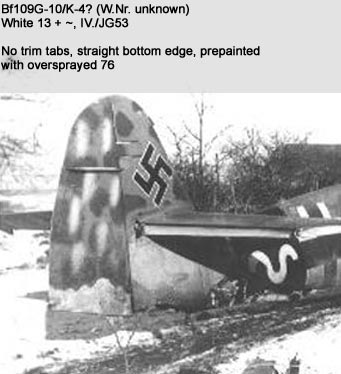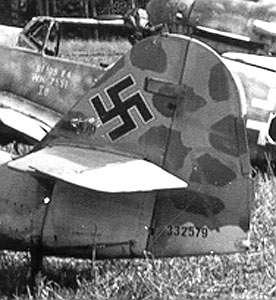A Tall Tail Tale-
The vertical stabilizer and rudder configuration of the 109 had remained consistent from the V1 of 1935 on through the G-6 of 1943. The constant process of marrying newer and more powerful engines to the existing airframe revealed the need for more positive lateral control. To accommodate this requirement, a simple but elegant solution was reached- a new 135mm tall fin cap now swept back to a perfectly straight rudder line as opposed to the angled counterbalance cutout on the previous fin. This cap was a straight "drop-fit" into the existing lower fin subassembly, and featured a rectangular cutout to allow room for the new rudder counterbalance. The "tall tail" appeared in at least five different variants according to Jean-Claude Mermet:
| - Reconstructed original rudders with the new straight rudder line and counterbalance. These were made from the original metal framed units with a wooden cap, and were covered in fabric. The existing tapered ground-adjustable trim tab was retained, a Flettner tab was installed immediately above this, and this Flettner was connected to the fin itself via an adjustable rod; the tab was intended to remain parallel to the direction of flight no matter what the deflection of the rudder. This setup was first noted on G-6/AS aircraft. Photo samples which show this style of rudder are at right: |
| - An all-wooden rudder of new construction which kept the Flettner tab, but dispensed with the tapered trim tab in favor of two ground adjustable rectangular tabs flanking the Flettner above and below. This rudder has a characteristic rounded "heel" beneath the aft position light. The counterbalance mount on the rudder appears to be rectangular in shape. Photo samples at right: |
|
| - A simplified wooden rudder with no external trim tabs (only the Flettner), and a straight angular heel to the rudder beneath the aft position light. |  |
| - The simplified rudder mentioned above is frequently noted with the external trim tabs; this is seen often enough to warrant mention as a separate item. Examples are shown at right; the photos of K-4 334265 and 464463 (Erla-built G-14, white 7) are courtesy James V. Crow via David E. Brown. |
| This further example of a K-4
(W.Nr. 332579, Schwarze 15 + ~ of 14./JG53) with the wooden rudder and two
tabs is interesting for another reason; note the aircraft immediately
behind it, and the inscription on the fuselage! It reads, "Bf
109 F 4 / WNr 7557 (perhaps 7553?) / IG (?)"
Thoughts on this highly unusual item are welcome on the Forum. (James V. Crow pic via David E. Brown) |
 |
| - Some rudders appeared to carry the ovoid taper of the rear fuselage through to the aft position light, giving the appearance of a "flattened cone", to quote Mermet. One possible example is shown at right, G-14/AS W.Nr.782354 of Ernst Scheufele; a far better pic appears at far right, this being the famous 5F+12 (W.Nr. 770269, G-10/R2) of NAgr14 landed at Fürth, Germany on V-E day. Note also the larger Flettner tab on 770269 as compared to 782354, the rectangular counterbalance mount, and the jagged edges of the rib tape applied to the rudder; these were cut out with pinking shears, and this photo is of sufficient quality to make this detail out. (Thanks to Pete Chalmers for this detail scan of the pic from Monogram Close-Up No. 7) |
| - There is a last variant which seems to be evident, and this would be a fabric-covered metal framed rudder with a straight lower edge, as shown in the photo at right: |
The wooden rudders were not intended as a metal-saving feature, but rather a way to simplify construction... Germany had an enormous recycling industry during the war, and a good example of just how vast this program was is featured in Hans Heiri Stapfer's "Strangers In A Strange Land" (Squadron Signal Publishing, ISBN 0-89747-198-9). Stapfer includes a chapter on the gargantuan recycling compound at Nanterre, France- the book is well worth a read!
As a further addendum to this discussion, there is a 10-page report concerning high speed testing of an F model fitted with the 135mm fin extension which may be found here; simply click the right side of each page to move forward, and the left side to go back to a previous page. Please note this report is a direct photocopy and as such is entirely in German; I'm currently investigating translation options, and anticipate having an English version available soon.